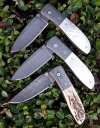Damascus can be very artistic and impressive, but coming from a background of studying nihonto (antique and traditionally forged Japanese swords) it usually appears extremely garish and overdone to me - especially after it's been aggressively etched. Japanese swords are folded (resulting in a fine layer pattern) and the resulting hada (grain) can take on any variety of patterns and characteristics, but in general it is far, FAR subtler than damascus. Often, to see some of the finest hada requires very careful lighting and a keen eye. By comparison, damascus (or more correctly pattern-welding) usually looks extremely "rough" and loose to me.
To address the idea of "layers" giving "strength" (feel free to skip the next few paragraphs if you want):
First off, let's distinguish between "true" damascus (i.e. "wootz" or crucible steel) and pattern-welding. Wootz was a fairly unique method of forging that resulted in a very heterogenous mixture of hardnesses/crystalline microstructures - which showed up as a fine watery pattern. If you see fine antique Middle Eastern shamshir, the effect can be very beautiful. This ingenious forging method, however, was born out of necessity since it was difficult with the materials and processes available to forge a full-length sword blade. The resulting blade will be quite nice and perform well, but a mix of such characteristics does not lend the blade the "best of all worlds" - it just serves as a compromise and makes for a blade with a variety of characteristics due to its uneven composition.
Now, modern "damascus" as it is usually applied to western custom knives is actually not wootz at all but deliberate pattern-welding. Pattern welding (as I'm sure most of you know) is the forging of contrasting steels together and folding/twisting them to create a deliberate pattern - which is subsequently enhanced (usually) through an etching process. The technique actually dates from "Viking"-era sword forging techniques - steelcraft at the time was capable of creating cables of steel, which were then joined together and twisted to create a full-sized billet suitable for sword construction. However, this again was a compromise feature, an ingenious method of overcoming a significant technological hurdle. The layering does not actually improve functionality - in fact, introducing so many welds into the equation merely increases the risk of forging a faulty blade.
Modern damascus is usually composed of steels chosen for their contrast - O1 and L6, for example. Since these modern steels are quite strong, and since modern tech allows a far greater degree of control over welding and forging, it is unlikely that a "damascus" blade will perform worse than any other finely heat treated handmade blade. But it does not gain any mystical functionality from being layered.
Possibly the greatest reason for folding and layering to be so revered and idolized is due to misconceptions regarding Japanese blades. Folding in nihonto was done to break up and diffuse the steel billet and its many impurities and uneven carbon content. It also served as an indirect control over the percentage of carbon content. In effect, it took primitive steel smelted out of iron sand and worked to homogenize it as much as possible. But a good modern steel, while lacking the beauty and character of a blade made from tamahagane (traditional Japanese steel), will usually outperform tamahagane all other things being considered equal (edge geometry, differential heat treatment, etc) - after all, it's *already* perfectly clean and homogenous, with no impurities. Folding such a steel will result in a beautiful pattern but will not improve the actual functionality. By the way, more layers does NOT equal a better blade! A Japanese blade was folded 7-15 times, resulting in anything from ~128 to ~32,000 layers (each fold doubles the layers). Folding the billet reduces carbon content and breaks up impurities/uneven carbon - by 32,000 layers the blade is pretty damn homogenous and has been for quite a number of folds already. Any more, and the carbon level gets ridiculously low (the billet itself begins losing a significant amount of mass) - way too soft and not enough steel for a sword. I'm not going to even begin to address lamination patterns (san mai, kobuse, etc.), which are a whole 'nother can of worms...
When one becomes accustomed to viewing the hada of blades such as a $200,000 masterpiece of artwork in steel by Nagasone Kotetsu, or a tanto by Rai Kunitoshi, and views the astounding and subtle hada that appears like a natural woodgrain that changes with the light and recedes into and back out of the steel, with patches of sparkling martensitic crystals and black shiny lines of activity and other metallurgical effects, the incredibly bold patterning of "damascus" in the modern knife world appears somewhat overdone and flat.
Not trying to start a war or anything, just explaining my own views. I have seen damascus pattern knives that I considered extremely beautiful, and of course the technique is one that requires intense focus and great skill. Heck, someone mentioned Kevin Cashen? I love his work even though he works outside of the field I study and enjoy principally. But there are reasons why one would actually not enjoy the type of damascus patterning seen on so many knives - it's to the point where I generally prefer a partially blued blade or a good ol' plain steel to many pattern-welded blades.
Er... so... yeah, you can send that Bowie over if you've been convinced that damascus ain't all that. ;-)

 The steel was 120 layer twist of 1095 and 15N20.
The steel was 120 layer twist of 1095 and 15N20.

